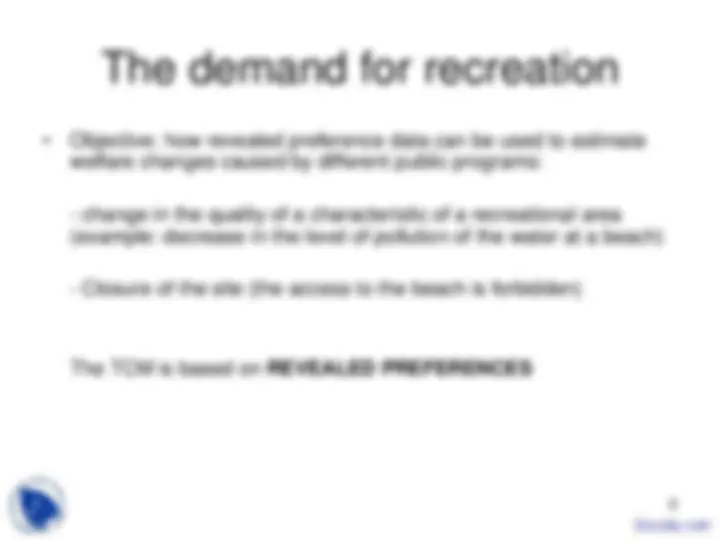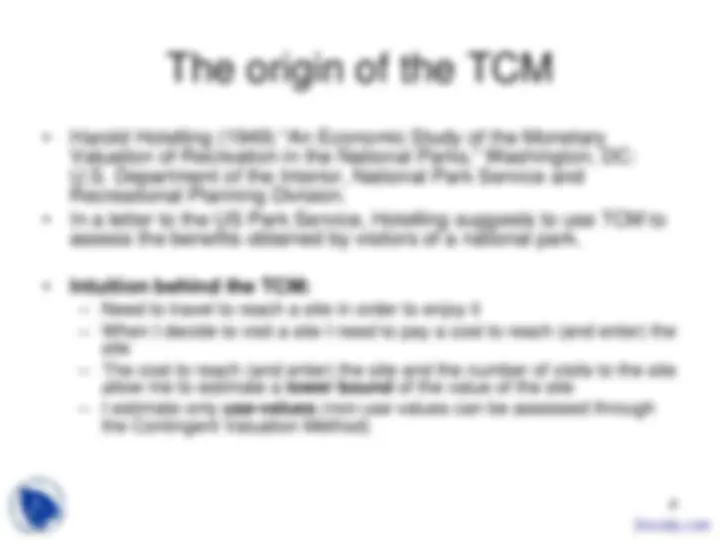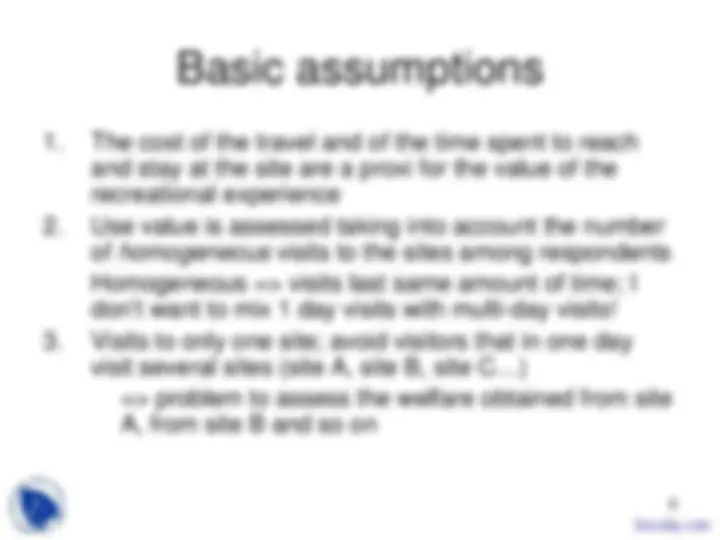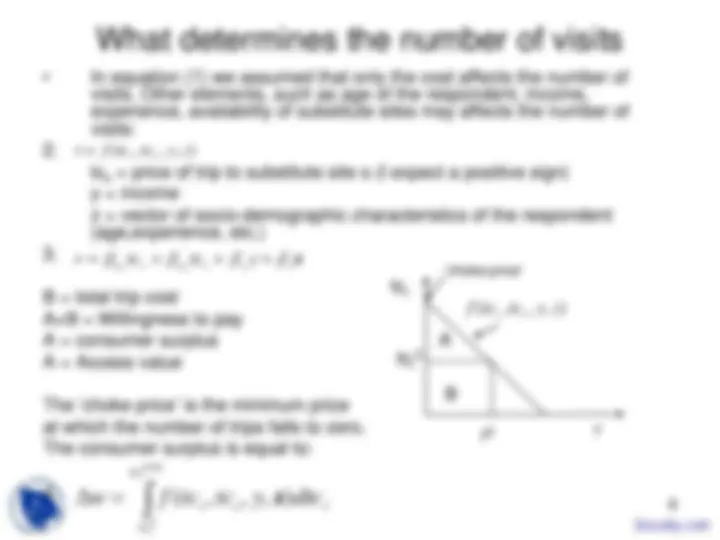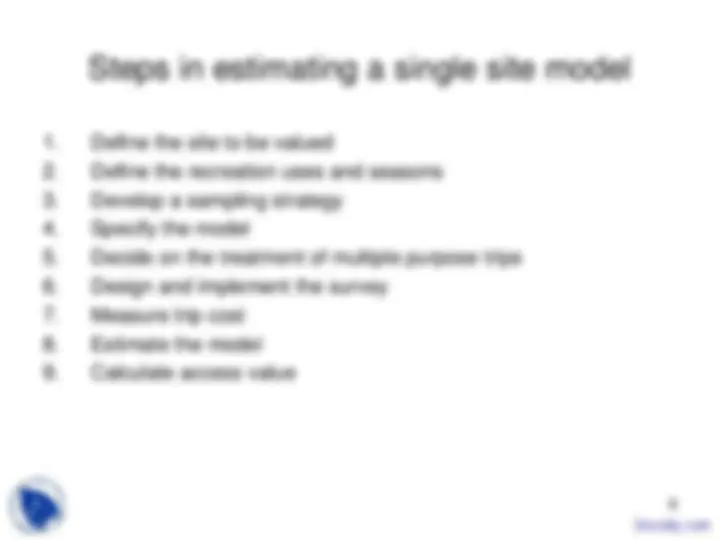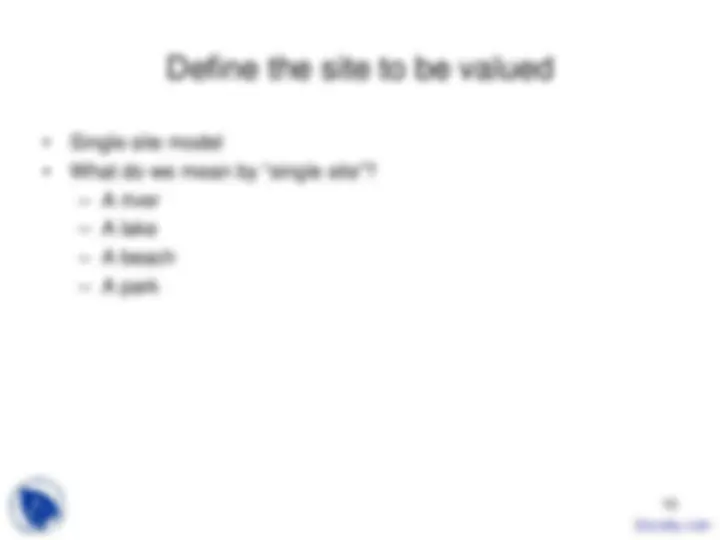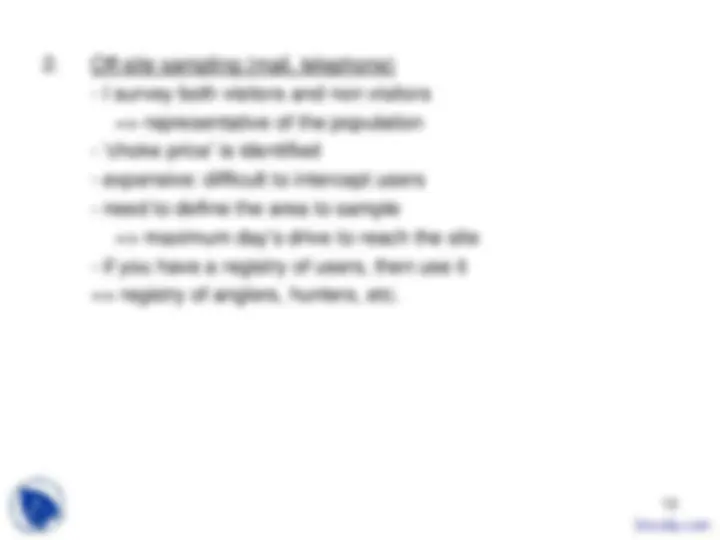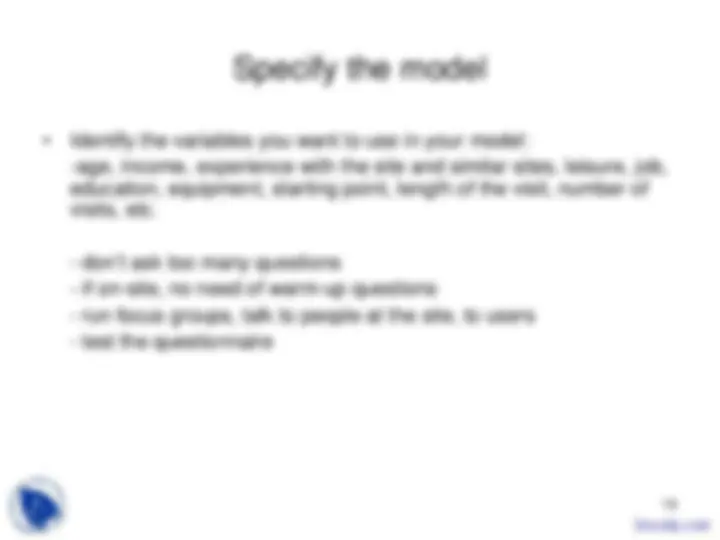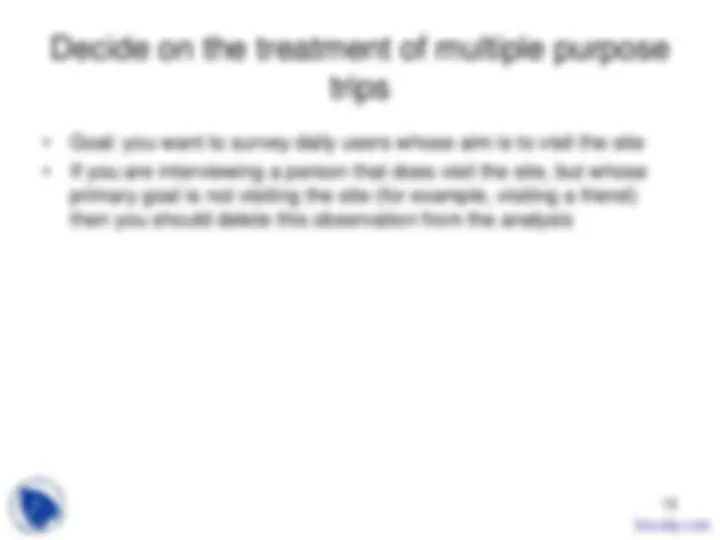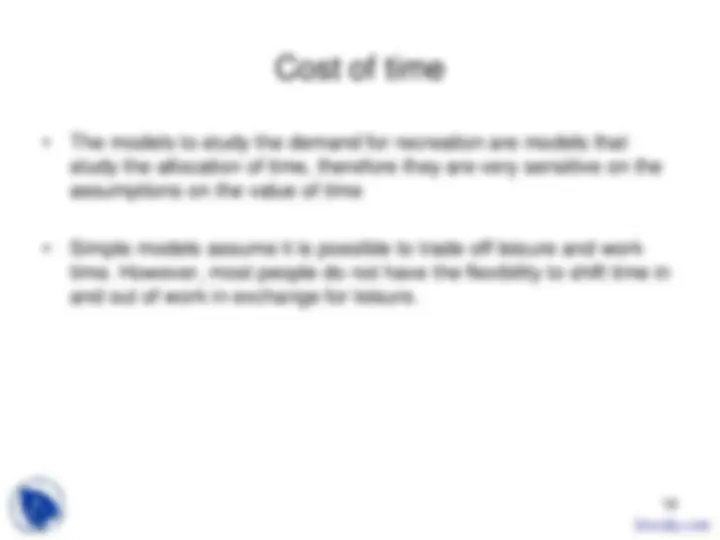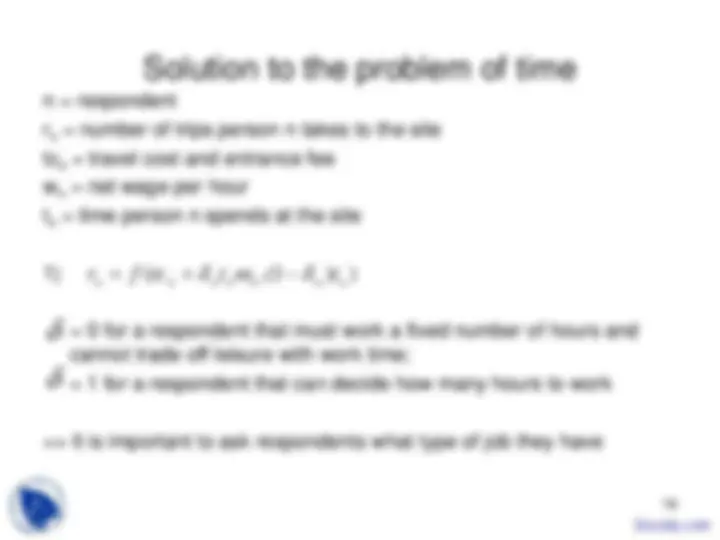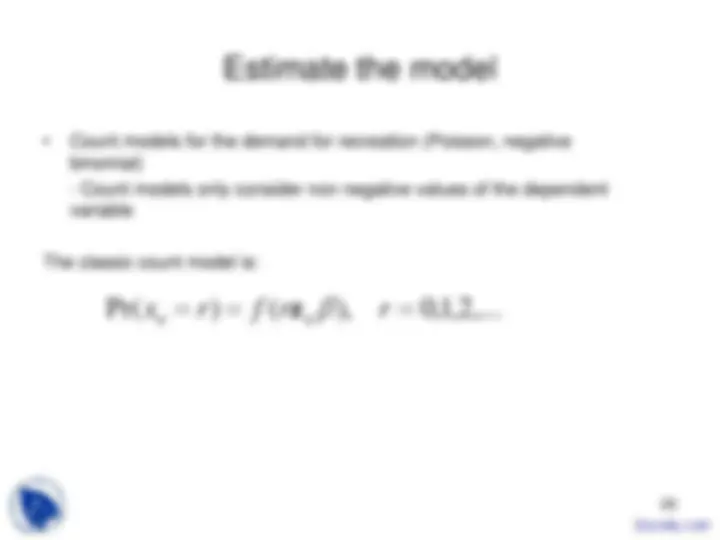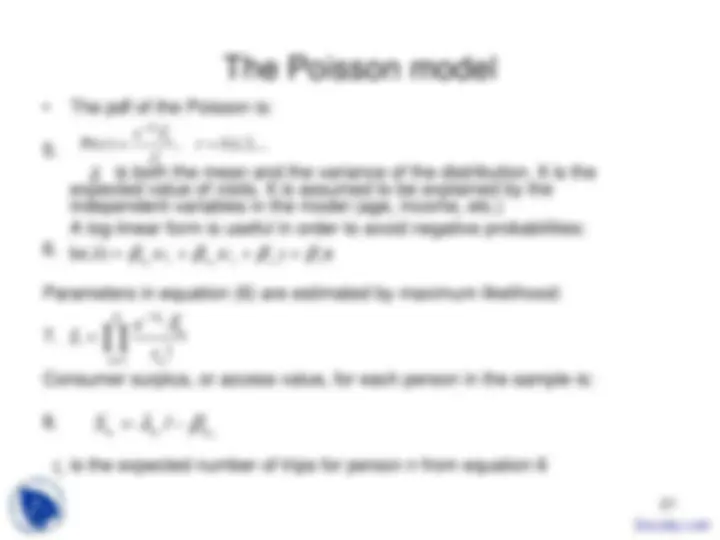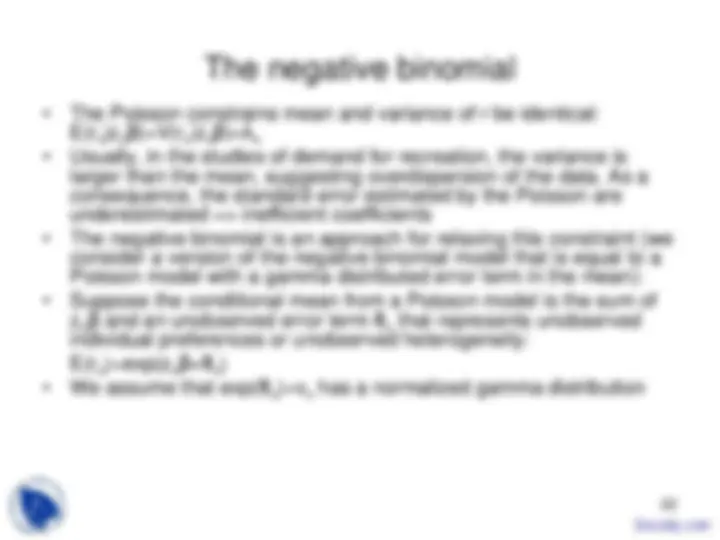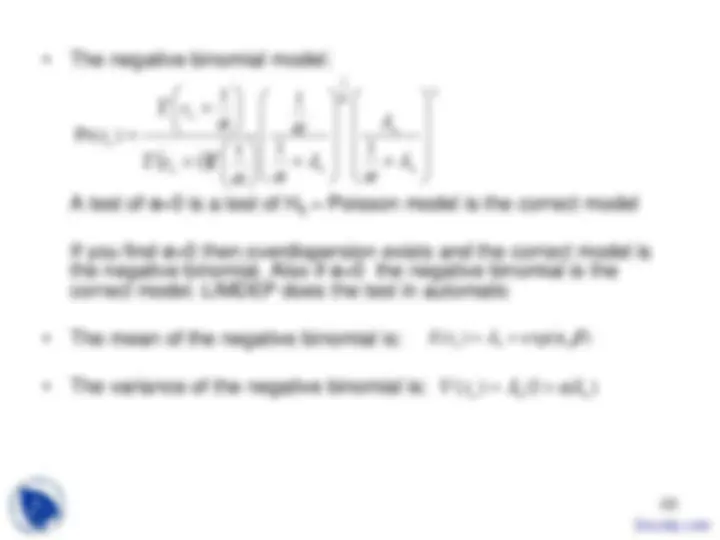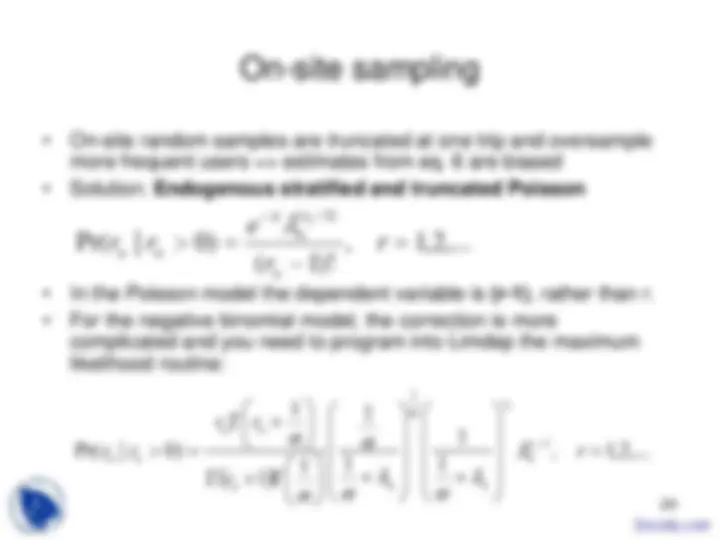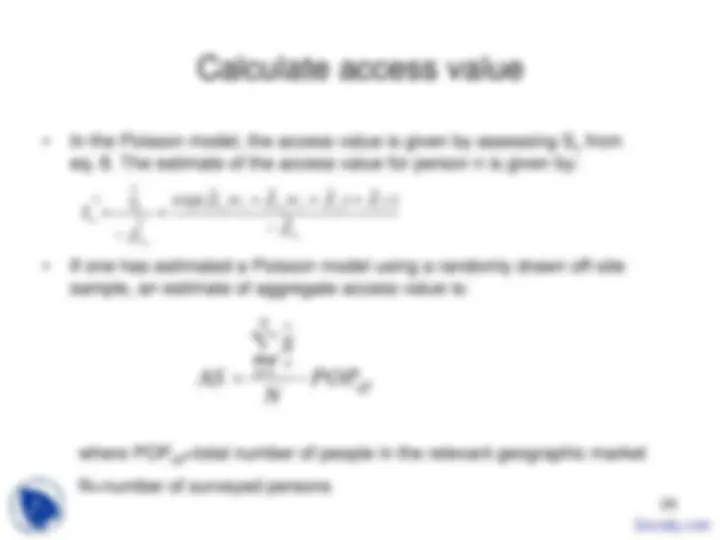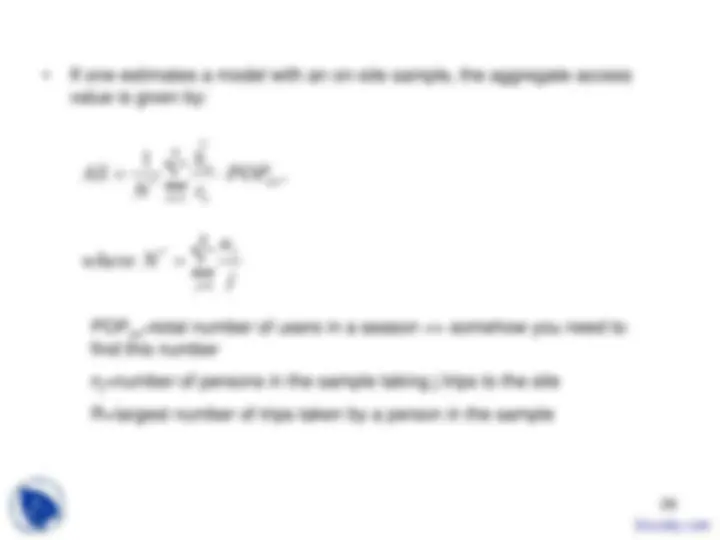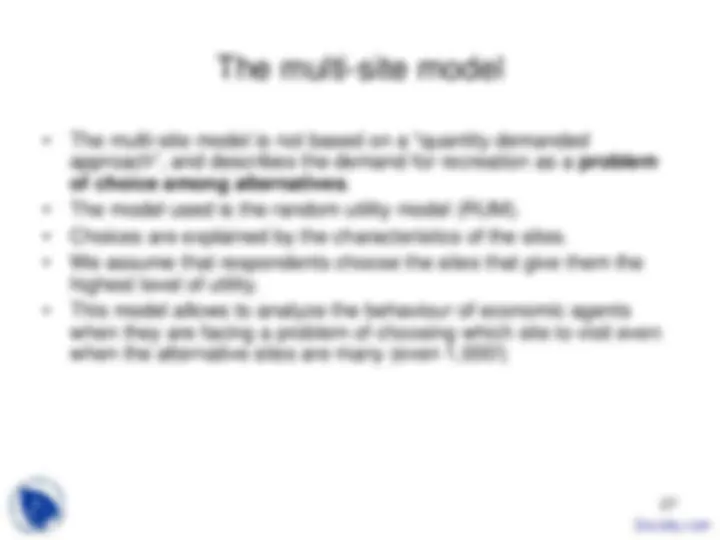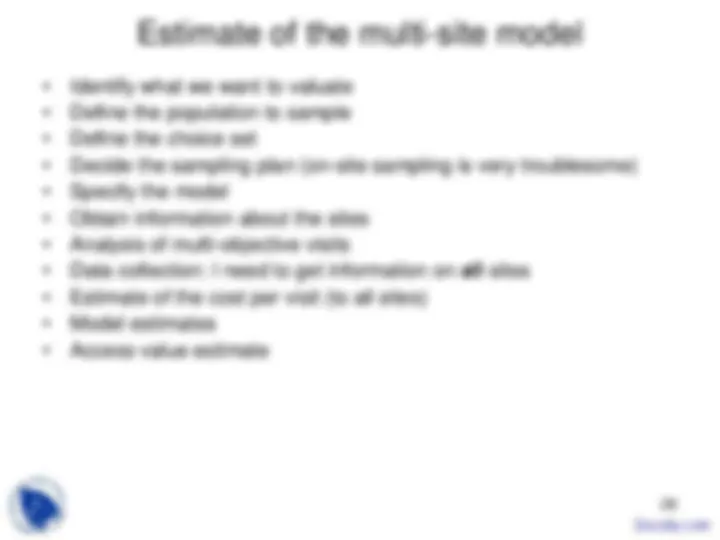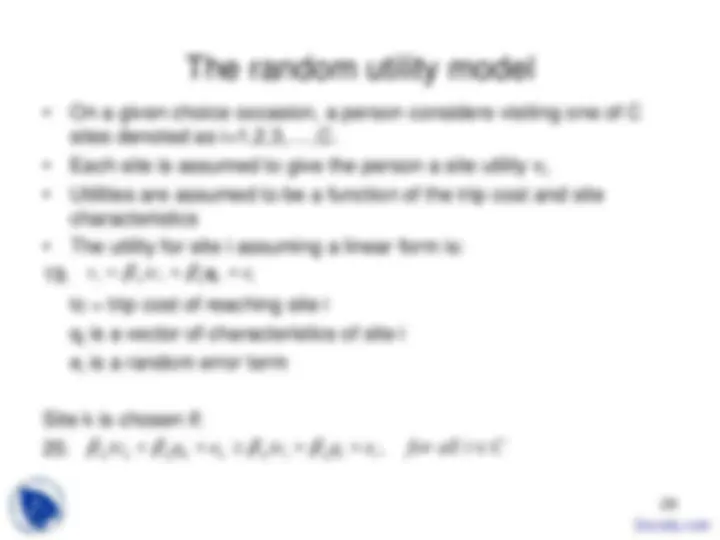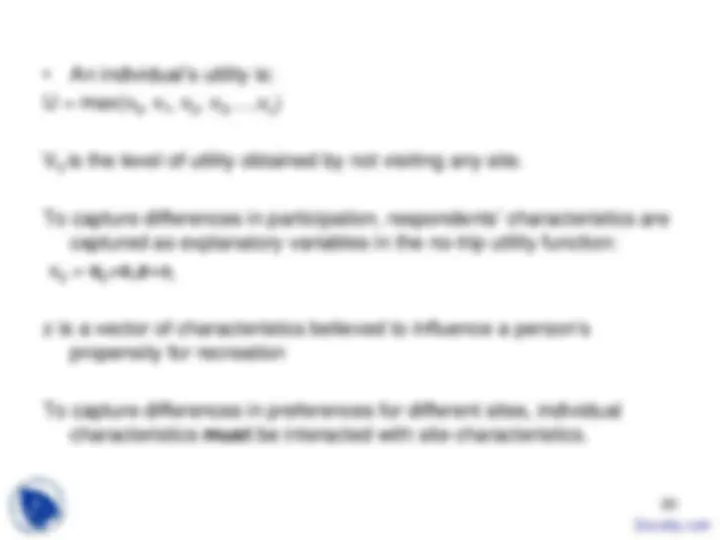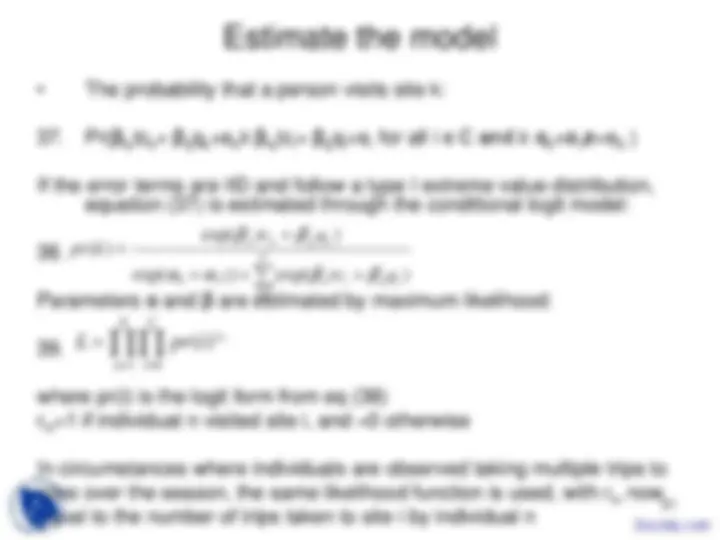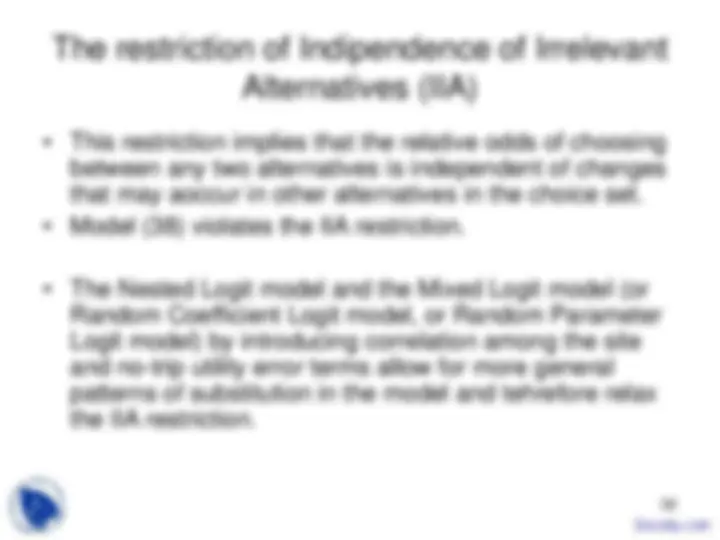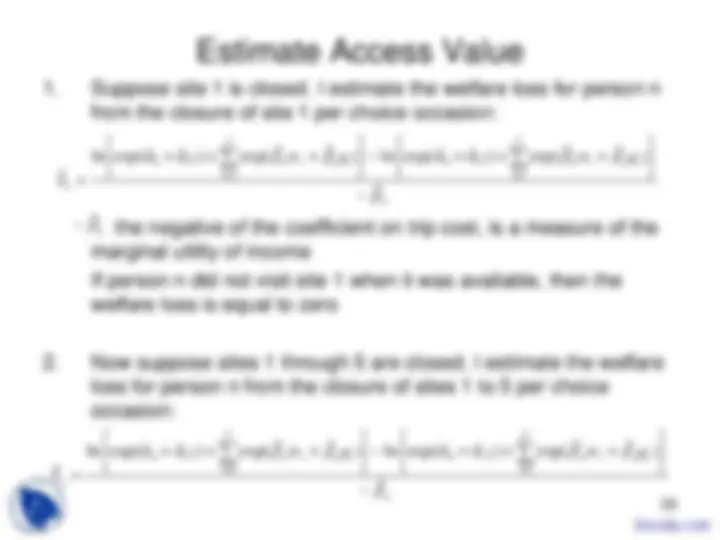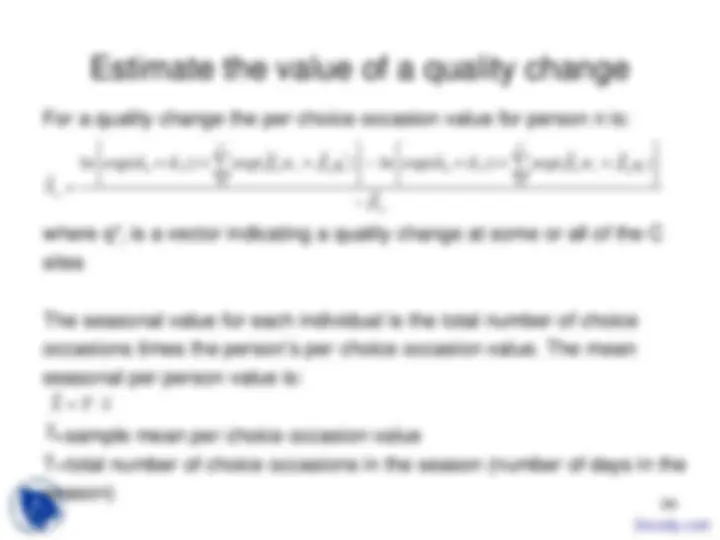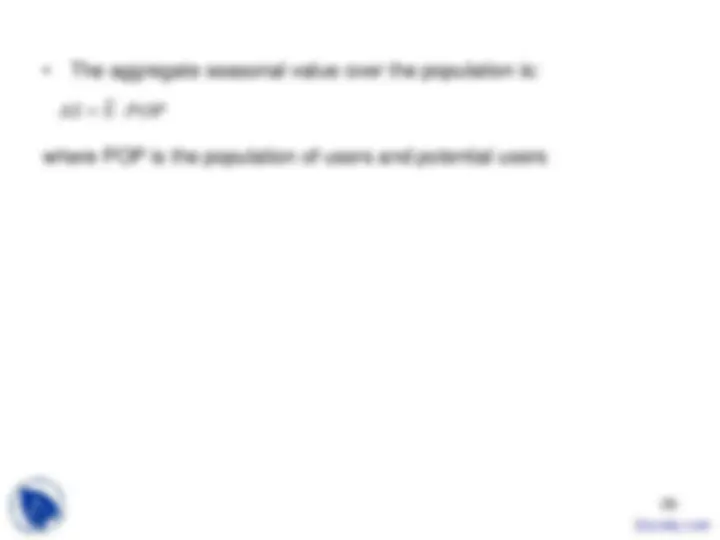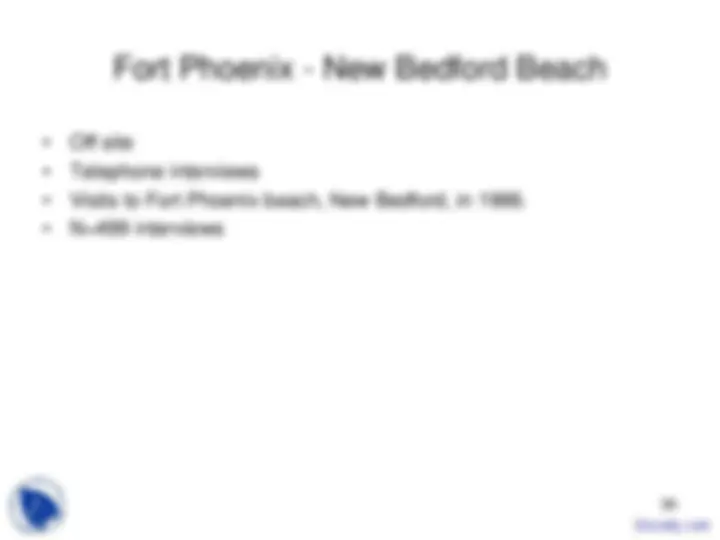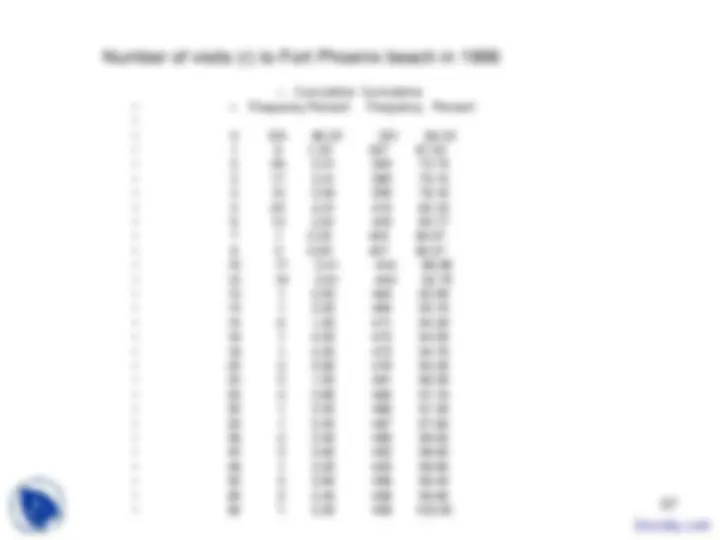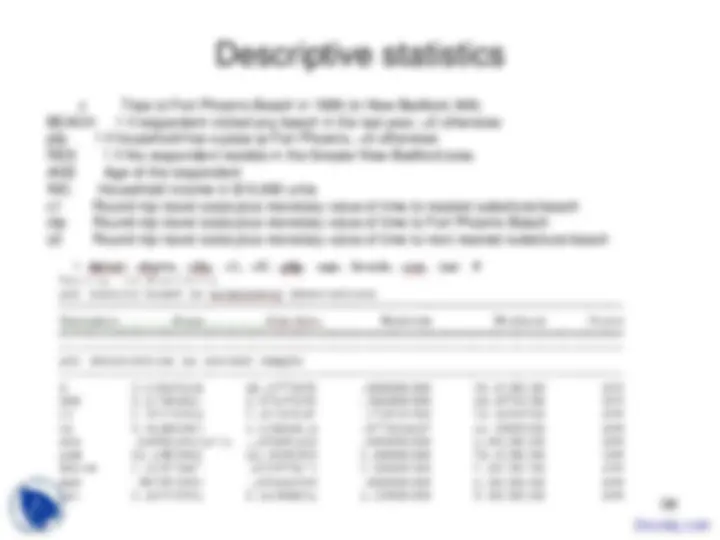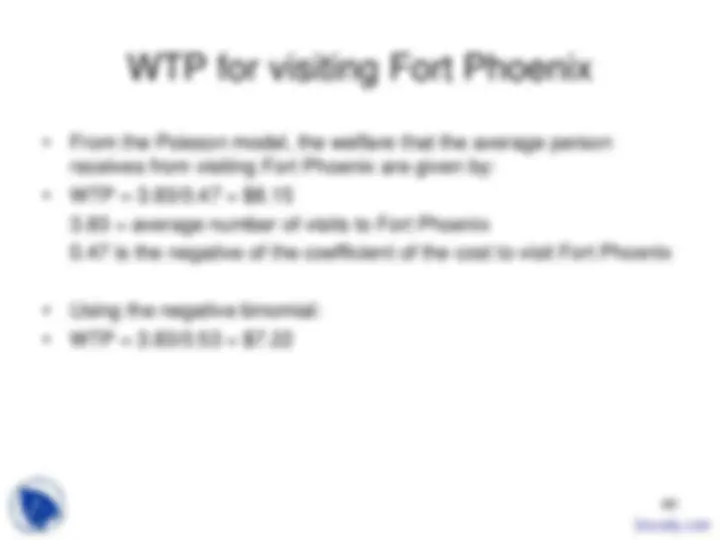Download Travel Cost Model - Environmental Economics - Lecture Slides and more Slides Environmental Economics in PDF only on Docsity!
1
The Travel Cost Model
2
The Travel Cost Model (TCM)
- The typical problem of the travel cost model
- Basic assumptions
- The single site model
- Poisson, Negative Binomial
- The problem of on-site sampling
- Example with Limdep
- The multi-site model
- Conditional logit model
- Independence of Irrelevant alternatives
4
The origin of the TCM
- Harold Hotelling (1949) “An Economic Study of the Monetary Valuation of Recreation in the National Parks,” Washington, DC: U.S. Department of the Interior, National Park Service and Recreational Planning Division.
- In a letter to the US Park Service, Hotelling suggests to use TCM to assess the benefits obtained by visitors of a national park.
- Intuition behind the TCM:
- Need to travel to reach a site in order to enjoy it
- When I decide to visit a site I need to pay a cost to reach (and enter) the site
- The cost to reach (and enter) the site and the number of visits to the site allow me to estimate a lower bound of the value of the site
- I estimate only use-values (non-use values can be assessed through the Contingent Valuation Method)
5
Basic assumptions
1. The cost of the travel and of the time spent to reach
and stay at the site are a proxi for the value of the
recreational experience
2. Use value is assessed taking into account the number
of homogeneous visits to the sites among respondents
Homogeneous => visits last same amount of time; I
don’t want to mix 1 day visits with multi-day visits!
3. Visits to only one site; avoid visitors that in one day
visit several sites (site A, site B, site C…)
=> problem to assess the welfare obtained from site
A, from site B and so on
7
The single site model
- The single site model describes the demand for recreation of a person during a season (12 months)
- The quantity demanded is the number of visits
- The price is the cost per visit
r = number of visits during a season tc (^) r = cost of a visit
Intuition: who lives close to the site has a low cost per visit. He should visit the site more often than someone who lives further away.
r = f ( tcr )
8
What determines the number of visits
- In equation (1) we assumed that only the cost affects the number of visits. Other elements, such as age of the respondent, income, experience, availability of substitute sites may affects the number of visits:
- tc (^) s = price of trip to substitute site s (I expect a positive sign) y = income z = vector of socio-demographic characteristics of the respondent (age,experience, etc.)
B = total trip cost A+B = Willingness to pay A = consumer surplus A = Access value
The ‘choke price’ is the minimum price at which the number of trips falls to zero. The consumer surplus is equal to:
r = f ( tcr , tcs , y , z )
r
tcr
B
A
r 0
tcr^0
f ( tcr , tcs , y , z )
r = β (^) tc (^) rtcr +β tcstcs +β yy + β z z ‘choke price’
r^ choke
r
tc
tc
w f tcr tcs y dtcr
0
( , , , z )
Docsity.com
10
Define the site to be valued
- Single site model
- What do we mean by “single site”?
- A river
- A lake
- A beach
- A park
11
Define the recreation uses and seasons
- What are the site’s functions? Only one function? Or several functions (beach: fishing, swimming, sailing, etc.)?
- Ask respondents what is their PRIMARILY purpose to visit the site
- If recreation types are similar we can aggregate observations, otherwise we cannot. - when you present your results, motivate why you aggregated data from different recreation types - It can be useful to use dummy variables to take into account different recreation types
- Decide the length of the season for recreation (summer, 12 months?)
- Decide carefully when to do the interviews
13
- Off-site sampling (mail, telephone)
- I survey both visitors and non visitors => representative of the population
- ‘choke price’ is identified
- expensive: difficult to intercept users
- need to define the area to sample => maximum day’s drive to reach the site
- if you have a registry of users, then use it => registry of anglers, hunters, etc.
14
Specify the model
- Identify the variables you want to use in your model:
-age, income, experience with the site and similar sites, leisure, job, education, equipment, starting point, length of the visit, number of visits, etc.
- don’t ask too many questions
- if on-site, no need of warm-up questions
- run focus groups, talk to people at the site, to users
- test the questionnaire
16
Design and implement the survey
- The questionnaire is composed by 4 parts:
- introduction
- questions on visits to the site (and other substitute
sites)
- questions on last visit (cost, number of people travelling
with, starting point, arrival, length, goal of the visit, etc.)
- socio-demographic characteristics of the respondent
- When to survey respondents? Not only on Saturdays
and Sundays!
17
Measure trip cost
- travel cost ( return cost )
- access fee
- equipment cost
- cost of time
19
Solution to the problem of time
n = respondent
r (^) n = number of trips person n takes to the site
tc (^) n = travel cost and entrance fee
wn = net wage per hour
t (^) n = time person n spends at the site
= 0 for a respondent that must work a fixed number of hours and cannot trade off leisure with work time; = 1 for a respondent that can decide how many hours to work
=> It is important to ask respondents what type of job they have
δ
rn = f ( tcn +δ ntn ω n ,( 1 − δ n ) tn )
δ
20
Estimate the model
- Count models for the demand for recreation (Poisson, negative binomial)
- Count models only consider non negative values of the dependent variable
The classic count model is:
Pr( x (^) n = r ) = f ( r z n β), r = 0 , 1 , 2 ,...

